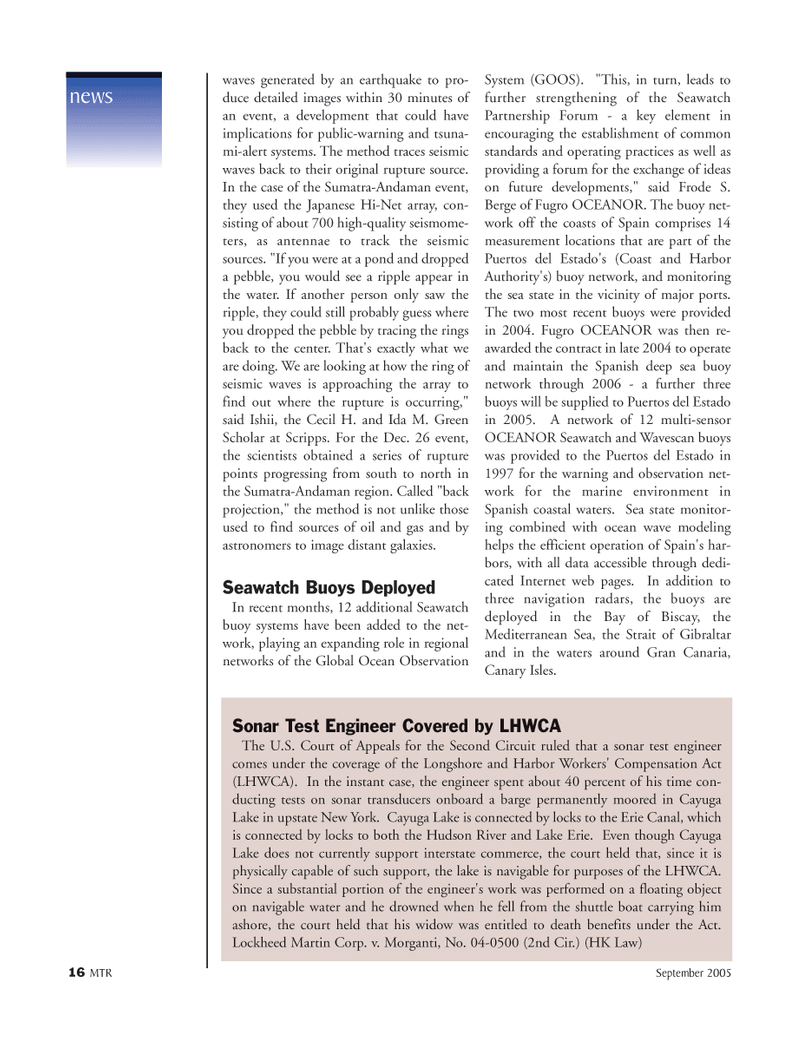
Page 16: of Marine Technology Magazine (September 2005)
Maritime Security & Undersea Defense
Read this page in Pdf, Flash or Html5 edition of September 2005 Marine Technology Magazine
16 MTR September 2005 waves generated by an earthquake to pro- duce detailed images within 30 minutes of an event, a development that could have implications for public-warning and tsuna- mi-alert systems. The method traces seismic waves back to their original rupture source.
In the case of the Sumatra-Andaman event, they used the Japanese Hi-Net array, con- sisting of about 700 high-quality seismome- ters, as antennae to track the seismic sources. "If you were at a pond and dropped a pebble, you would see a ripple appear in the water. If another person only saw the ripple, they could still probably guess where you dropped the pebble by tracing the rings back to the center. That's exactly what we are doing. We are looking at how the ring of seismic waves is approaching the array to find out where the rupture is occurring," said Ishii, the Cecil H. and Ida M. Green
Scholar at Scripps. For the Dec. 26 event, the scientists obtained a series of rupture points progressing from south to north in the Sumatra-Andaman region. Called "back projection," the method is not unlike those used to find sources of oil and gas and by astronomers to image distant galaxies.
Seawatch Buoys Deployed
In recent months, 12 additional Seawatch buoy systems have been added to the net- work, playing an expanding role in regional networks of the Global Ocean Observation
System (GOOS). "This, in turn, leads to further strengthening of the Seawatch
Partnership Forum - a key element in encouraging the establishment of common standards and operating practices as well as providing a forum for the exchange of ideas on future developments," said Frode S.
Berge of Fugro OCEANOR. The buoy net- work off the coasts of Spain comprises 14 measurement locations that are part of the
Puertos del Estado's (Coast and Harbor
Authority's) buoy network, and monitoring the sea state in the vicinity of major ports.
The two most recent buoys were provided in 2004. Fugro OCEANOR was then re- awarded the contract in late 2004 to operate and maintain the Spanish deep sea buoy network through 2006 - a further three buoys will be supplied to Puertos del Estado in 2005. A network of 12 multi-sensor
OCEANOR Seawatch and Wavescan buoys was provided to the Puertos del Estado in 1997 for the warning and observation net- work for the marine environment in
Spanish coastal waters. Sea state monitor- ing combined with ocean wave modeling helps the efficient operation of Spain's har- bors, with all data accessible through dedi- cated Internet web pages. In addition to three navigation radars, the buoys are deployed in the Bay of Biscay, the
Mediterranean Sea, the Strait of Gibraltar and in the waters around Gran Canaria,
Canary Isles. news
Sonar Test Engineer Covered by LHWCA
The U.S. Court of Appeals for the Second Circuit ruled that a sonar test engineer comes under the coverage of the Longshore and Harbor Workers' Compensation Act (LHWCA). In the instant case, the engineer spent about 40 percent of his time con- ducting tests on sonar transducers onboard a barge permanently moored in Cayuga
Lake in upstate New York. Cayuga Lake is connected by locks to the Erie Canal, which is connected by locks to both the Hudson River and Lake Erie. Even though Cayuga
Lake does not currently support interstate commerce, the court held that, since it is physically capable of such support, the lake is navigable for purposes of the LHWCA.
Since a substantial portion of the engineer's work was performed on a floating object on navigable water and he drowned when he fell from the shuttle boat carrying him ashore, the court held that his widow was entitled to death benefits under the Act.
Lockheed Martin Corp. v. Morganti, No. 04-0500 (2nd Cir.) (HK Law)
MTR#2 (1-16).qxd 8/30/2005 4:48 PM Page 18

 15
15

 17
17
